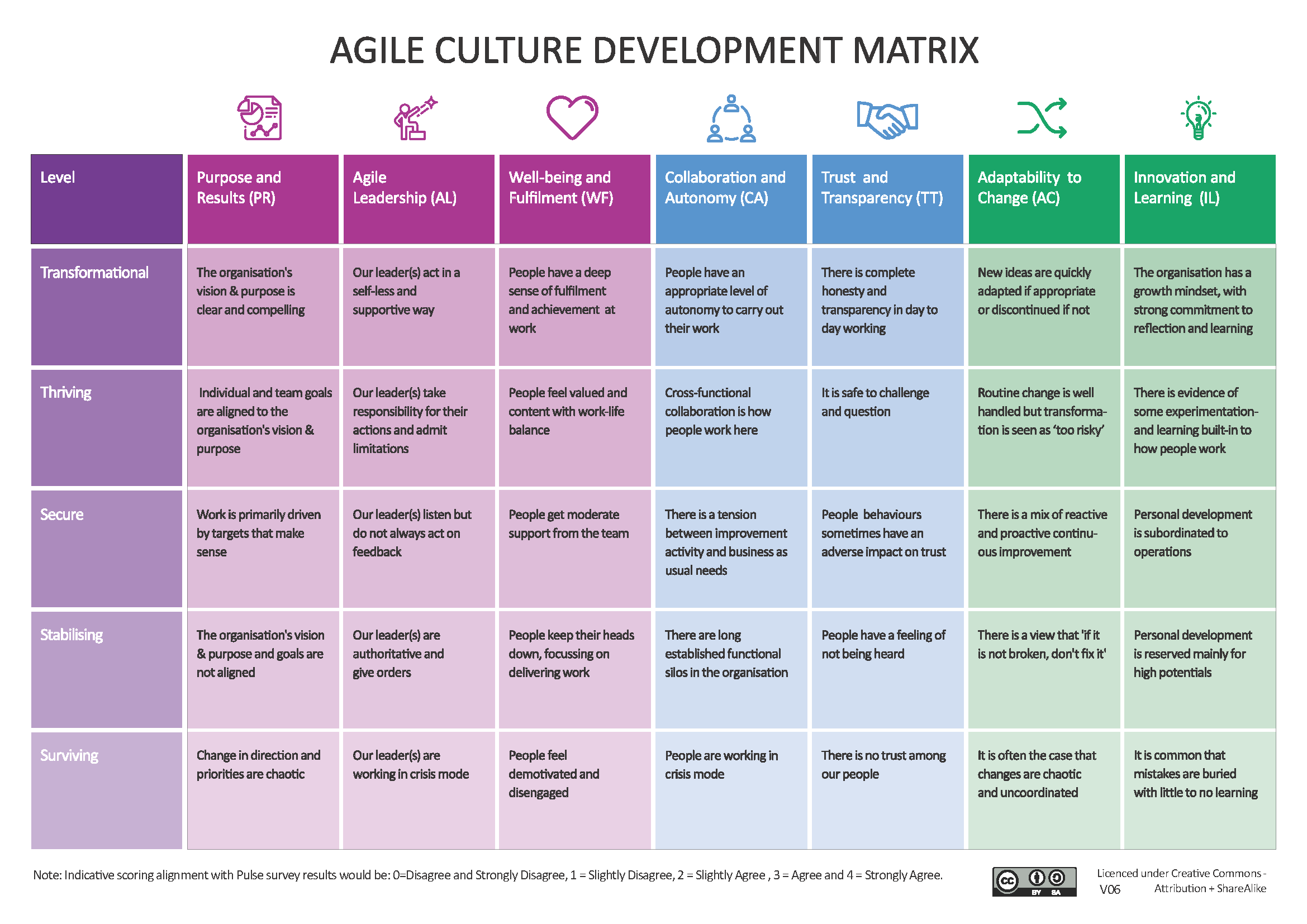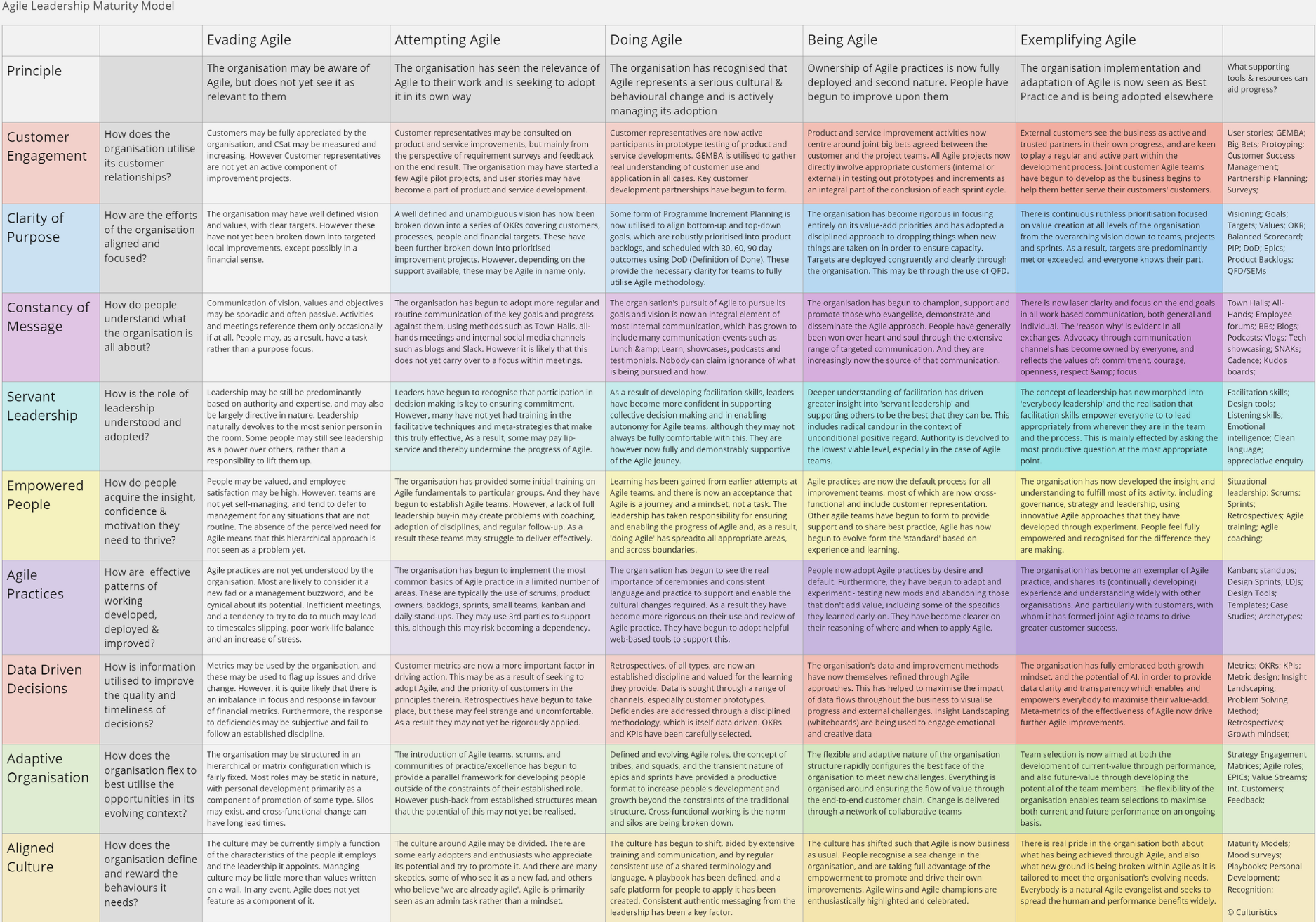“Well, of course, we've always been Agile! We're continually having to change things at the last minute.”
How often have you heard these words or something like them?
Business Agility has a tremendous amount to offer organisations of all shapes and sizes. But, as with all change, businesses will only reap these benefits when they take real ownership in adopting Agile practices. Simply relabelling existing, and even knee-jerk, practices as ‘agile’ just won't cut it.
As management consultants, we have spent 35 years developing and applying strategies to engage client commitment for change. To be those people who 'borrow your watch and tell you the time'. Because the fact that it is YOUR watch makes all the difference to what you will do about it. And we have found that one of the most effective mechanisms for engaging client commitment, particularly in respect of clear and focused action, is to use a word matrix to easily display the relationship between concepts and, in this case, learning.

As an example, The Agile Culture Development Matrix (shown) describes an organisation’s current level of culture (X axis) across the different elements that make up an agile culture (Y axis) to display common behaviours in each intersecting box. This provides a useful illustration of how such models work.
The agnostic model
There are two things to note on The Agile Culture Development Matrix. The first is that it deliberately distances itself from any idea of organisational or agile maturity.
The second is that it is agnostic in respect of the means utilised to achieve the different developmental levels. Therefore, it is possible to achieve progress without utilising any of the typical practices or ceremonies commonly associated with Agile, such as: Scrum, Kanban, stand-ups, retrospectives, sprints etcetera, or indeed any nominated alternatives to these practices.
Such agnosticism can be very empowering to a team who already has shared ownership of its journey and is seeking to use such tools as a learning framework. However, the lack of evidential criteria poses two potential difficulties for teams that are, as yet, some way away from this mindset.
Firstly, its openness to interpretation can make it difficult to reconcile arguments between those who want to learn, and those who want to justify their current standpoints. And secondly, the lack of specific approaches makes it more difficult to understand what steps to take to progress to the next level.
We have developed these ideas further into something called a Maturity Model.
Maturity Models, used the right way, have the ability to drive ownership and consensus for three really important outcomes:
- Shared acceptance of the current situation
- Agreement on a desired and defined future situation
- Practical and proven actions to move between the two
So, what are Maturity Models, how do they work, and how can you use them within an organisation to achieve these outcomes?
What are Maturity Models?
Wikipedia defines maturity models as: frameworks for measuring … the ability of an organisation for continuous improvement in a particular discipline. The higher the maturity, the higher will be the chances that incidents or errors will lead to improvements either in the quality or in the use of the resources of the discipline as implemented by the organisation.
Our specific model
Faced with a group which has a propensity to simply re-label existing practices as agile, we have found that it is helpful, initially at least, to utilise a maturity model which references more specific criteria for the achievement of higher levels. An example of this, based on the learnings and cited practices from the 2023 Agile Business Award presentations, can be found below (view as PDF here).

How do they work?
The words within the Maturity Model are not as important as the discussion that takes place around them. Maturity Models are first and foremost a catalyst for the group to have meaningful and productive discussions on their own terms regarding: where they are; where they want to be; and what they need to do to get there.
Rules
However, to achieve this quality of debate, we find that it is really helpful to introduce a couple of rules and to enforce them rigidly.
The first rule is that you can only rate yourself at a level of progress, on any particular aspect, where ALL the criteria have been met in that cell. Initially, this can create a reaction in a group who feel that the next cell more fairly reflects their situation. However, if you accept this argument, you then enter into a whole world of subjectivity around 'how much is enough to claim a cell?' - and conversations that take much longer than they need to. It often helps to gently remind the group that the purpose of the model is about learning, rather than about justifying the group's ego, or marketing their achievements. It is also good to point out that it won't take much of a change to make rapid progress to legitimately achieve the next cell.
However, if a cell contains something they definitely choose not to do, it can be edited out of the model in the next cycle. After all, in the spirit of ownership, it will be their model. And they are unlikely to make such changes lightly.
The second rule is that the group must develop consensus between themselves on which cells they are going to settle on. Often, progress is not homogenous across an organisation and so different parts of the organisation, different leaders, will perceive different answers. But the first rule indicates that the collective progress is the progress of the weakest area. This again may be difficult for people to accept, but it does mean that mutual support is likely to increase, and easy to fix changes will take place quickly.
More importantly, these rules make it more likely that discussion is full and candid. And it is this sort of discussion that is the whole purpose of the Maturity Model. It is this sort of discussion that builds collective ownership and commitment, both with regard to the current situation and the intended future situation. It also builds the steps that need to be taken to move from one to the other.
Crucially, all the time, it is the participants making the actual decisions. All the consultant or facilitator needs to do is to hold them to the process and ensure the dialogue doesn't get bogged down.
How can you use them?
The first step is winning the client organisation over to their use. Then, once they have begun to look at the descriptions, they are usually engaged by the relationships within the tool and how it builds into a logical step-by-step journey. Beyond that, it is simply about getting people to think about where their organisation (or team) sits on the model, and where people would like it to sit in the future.
This is best done individually in the first instance. To achieve this, provide people with their own copy of the model, and explain the first rule to them. Then get them to mark on the page, against each aspect, the cell that best describes what has already been achieved (the current status), and the cell that best describes how they aspire to see the organisation perform within a (defined) practical timescale.
A combined view
Once this has been done and any questions have been addressed, people mark their initial answers on a collective sheet (either on a large section of wall or on an online whiteboard) so they can see where there is already agreement, and where there is diversity of opinion. This is an opportune time to explain that a collective view will now be developed together using consensus, and to explain what consensus is and how it will work.
As long as people believe that they have been properly heard and that the process for arriving at the final answer was fair, they will (if they are reasonable - and most people are) support the majority view. In getting to this point, it may be useful to remind them of some fundamental truths:
- It is more about the discussion than it is about the final rating - the rating process is predominantly a means to an end.
- This is not a final score, it is a means to identify how to make progress, and it is something to be revisited as that happens. Between this time and the first revisit, evidence can be gathered that will help move the discussion forward.
- It is more helpful that we take opportunities to make progress that is 80 per cent right and fix the other 20 per cent as we gather insights on the way, than it is to argue fruitlessly over that 20 per cent while standing still.
Once the group has reached consensus on the current and the desired future status, it is easy to see within the model the things that are required to close the gap. These can then be prioritised and scheduled as team projects to bring about the required changes.
Please note: blogs reflect the opinions of their authors and do not necessarily reflect the recommendations or guidance of the Agile Business Consortium.
